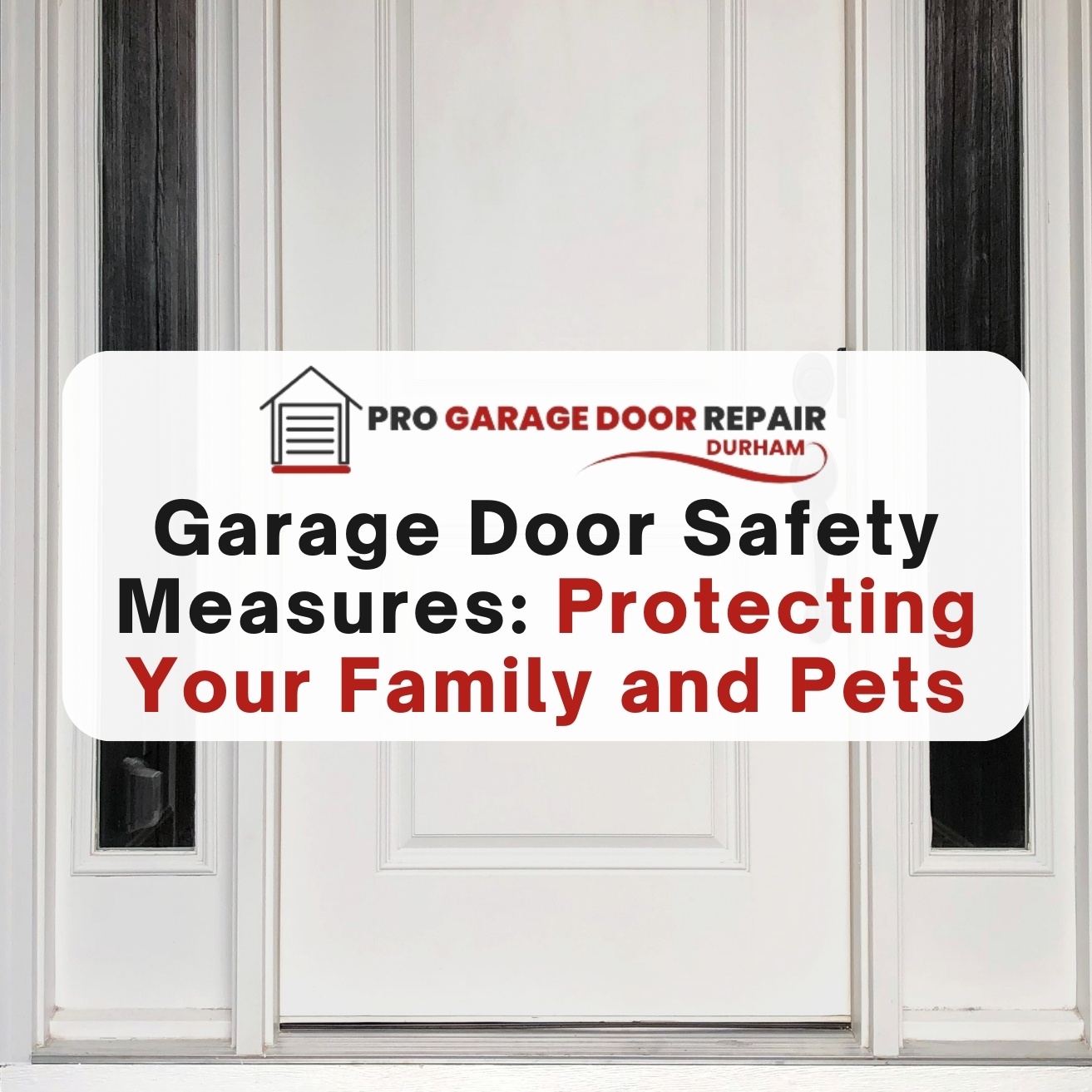Garage doors may seem harmless, but they pose serious safety risks that too often lead to tragic accidents involving both children and pets. Proper precautions and preventive measures are essential for protecting your loved ones. This guide covers the array of potential garage door dangers and provides actionable recommendations on safety-proofing your garage.
The Startling Dangers of Unsafe Garage Doors
A garage door accident can happen in mere seconds with absolutely devastating consequences. Over 20,000 people each year end up hospitalized due to garage door injuries, per Stanford University research.
Children are especially vulnerable to the following hazards:
- Getting trapped under the door as it closes, which can lead to suffocation or life-altering head/neck injuries
- Having body parts get caught in moving hinge or spring mechanisms
- Strangulation from pull cords used to manually open the door
- Wandering into the garage unsupervised and accessing dangerous tools/chemicals
Pets too face risks like:
- Getting hit by a closing garage door and suffering injuries or even death
- Having paws, tails, or legs caught in the hinge side of doors
- Strangulation from chewing on hanging pull-cord ropes
These dangers demonstrate why proactively taking garage door safety measures is so vital for family households. The rest of this guide details steps that homeowners must take to best protect their loved ones.
Step #1: Install Essential Garage Door Safety Features
The Consumer Product Safety Commission advises installing the following three safety devices to prevent kids and pets from suffering tragic garage door accidents:

Photo Eyes
Photo eye sensors project an invisible beam across the bottom of the garage entrance. If anything obstructs this beam while the door is closing, the sensors trigger the door to immediately reverse direction and open. This prevents individuals or pets from being pinned or trapped underneath.
Edge Sensors
Edge sensors consist of a pressure-sensitive strip running along the bottom edge of the garage door. If the descending door makes contact with an object or body part, the strip presses in to trigger the motor reversal mechanism. This stops the door from crushing someone or something underneath.
Automatic Door Locks
Secure your closed garage door against unauthorized entry by installing automatic deadbolt locks. This prevents kids or pets from wandering inside and accessing dangers. It also deters intruders lacking the remote access device or entry code.
Step #2: Perform Proactive Maintenance and Inspections
While safety accessories provide important safeguards, only proactive maintenance ensures their dependable functioning. schedule bi-annual professional tune-ups and take the following Do-It-Yourself (DIY) steps:
Conduct monthly inspections:
- Check all cables and pulleys for fraying or cracking
- Ensure the door opener motor functions properly in both directions
- Confirm tracks remain aligned and free of debris buildup
- Examine hinges, springs, and rollers for visible wear or damage
- Test the sensitivity and accuracy of safety sensor beams
Perform monthly functionality tests:
- Manually disconnect and reconnect the door while checking for smooth operation
- Conduct obstruction tests that trigger the auto-reverse mechanism upon contact
- Ensure emergency release cords properly detach the door from motor pulleys
Replace components proactively:
Do not wait for total failure before replacing worn parts. Be proactive by swapping out:
- Fraying or stretched cables every 1-2 years
- Weakening torsion springs every 3-7 years
- Hinge bearings/bushings every 4-7 years
Step #3: Follow Safe Operating Procedures
Even garage doors outfitted with safety features can inflict harm if used incorrectly. Families should institute the following usage guidelines:
- Only operate a garage door while within clear sight of it
- Fully open or close the door after each use instead of leaving it halfway
- Keep children and pets out of the area while opening/closing the door
- Verbally warn others before setting the door in motion
Furthermore, develop smart habits such as:
- Scanning below the door prior to closing to check for potential obstructions
- Testing the auto-reverse function monthly by blocking the safety sensors
- Keeping remote transmitters/entry code out of reach of children
For more information on services, contact us at Pro Garage Door Services.
Step #4: Take Extra Measures to Protect Pets

Pets face unique garage door dangers that require additional safety steps:
Restrict Pet Access
Block pets from entering the garage whenever an automatic door is in use. Consider installing indoor/outdoor pet gates that allow family members to enter but deter pets.
Post Warning Signs
Affix conspicuous warnings on both interior and exterior garage door surfaces reminding residents not to operate the door with pets nearby. Fluorescent signage visible from a distance best grabs attention prior to pushing the remote’s button.
Train Pets
Work with pets early on to condition avoidance behavior whenever they hear a garage door activating. Useful techniques include rewards-based training with a clicker or establishing an area well away from the door’s pathway as the pet’s preferred relaxation space.
Install Flashing Lights
Sensors that trigger flashing strobe lights whenever the garage door activates make the action highly visible. This helps prevent people from remotely activating the door without noticing an approaching pet.
What To Do If Someone Gets Trapped
In case a child, pet, or adult gets trapped underneath a malfunctioning garage door:
Activate the Emergency Release
Every garage door features a red emergency cord that allows manual detachment of the door from the pulley/opener system. Pulling this disengages the motor so the door easily lifts by hand off the trapped victim.
Call Emergency Services
Emergency personnel with proper lifting equipment must still report to the scene to safely maneuver the released door out of the way without harming the victim further. This also facilitates urgent medical transport for injury assessment/treatment if necessary. Never attempt moving the heavy released door on your own.
Administer First Aid
While awaiting emergency responders, check for signs of breathing/pulse and provide CPR or stop bleeding if possible. Follow dispatcher instructions and do not move victims with suspected neck/spine injury. Provide verbal reassurance and avoid agitating pets further until professionals complete the rescue.
Conclusion
Garage doors must be treated with healthy caution and respect. But homeowners willing to proactively install safety features, maintain proper functionality through inspection/upkeep, institute safe operational habits, and take measures tailored to protecting pets can largely eliminate the risk of harm befalling their loved ones. Stay vigilant and don’t let your garage become a safety liability.
How much weight can garage door photo eyes sense and trigger reversal for?
A: Standard photo eyes reliably detect objects or limbs over 3 inches tall laying in the door pathway, with sensitivity to sense items under 1 lb to trigger auto-reverse.
Does homeowners insurance cover garage door injuries?
A: Contact your provider, as policies vary. Home liability insurance should cover guest medical bills if the unsafe door caused injury. Homeowners policies generally cover repair/replacement costs as well.
Can I disable auto-reverse on my garage door?
A: No, disabling the auto-reverse safety function violates codes everywhere. Tampering with this mechanism put lives at risk and leads to liability issues.
How often do garage door springs need replacement?
A: Torsion springs lasting 3-7 years see regular household use. Check for cracks or grinding noises annually. Schedule proactive replacement once they near or exceed the expected lifespan.




